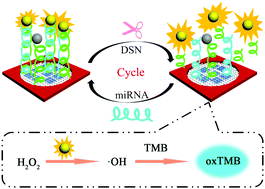Double signal amplification based on palladium nanoclusters and nucleic acid cycles on a μPAD for dual-model detection of microRNAs†
Abstract
MicroRNAs (miRNAs) are a class of significant biomarkers; however, it is still a huge challenge to express them accurately. Herein, a fluorescent/colorimetric dual-model biosensor based upon the quenching effect of graphitic carbon nitride on palladium nanoclusters (Pd NCs) on the platform of a microfluidic paper-based analytical device was built for the detection of miRNAs. On the one hand, Pd NCs could catalyze a chromogenic reaction so that preliminary detection was achieved by the naked eye. On the other hand, the fluorescence analysis combined with nucleic acid cycle signal amplification was required to get precise result and the detection limit is 3 fM, which was superior to the previous method. What's more, this biosensor could be designed to detect other miRNAs via changing the corresponding aptamer sequences. Therefore, the as-constructed biosensor supplies a versatile platform to conduct point-of-care detection of miRNAs with outstanding performance.



 Please wait while we load your content...
Please wait while we load your content...